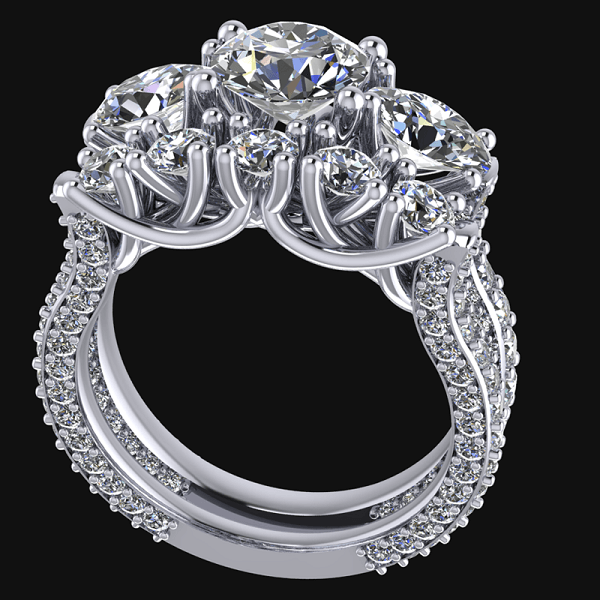Jewelry Cleaning Tips
Jewelry Cleaning Tips | BVW Jewelers
Restore Your Jewelry's Shine with Simple Jewelry Cleaning Tips
If you want to clean your jewelry and restore its sparkle, we’ve got great news: the best jewelry cleaning methods are often the simplest. The most challenging part of cleaning your jewelry is knowing how to avoid common mistakes that can accidentally damage your valuable pieces. With that in mind, we’ve gathered our top Jewelry Cleaning Tips to ensure your jewelry stays in top condition while you safely bring back its brilliance. Here are 6 essential tips everyone should follow.

Tip #1: Use the At-Home Soap and Water Method As Part Of Your Jewelry Cleaning Tips
One of the easiest, safest, and most effective methods of jewelry cleaning tips, is for cleaning your jewelry at home is using a simple soap and water solution. To do this, you’ll need warm water, a small bowl, mild dish soap, a soft toothbrush, and a soft cloth. Follow these easy steps for more Jewelry Cleaning Tips:
- Create a solution: Fill a bowl with warm (not hot) water and add a few drops of dish soap. Avoid moisturizing soaps, as they can leave a film on your jewelry.
- Soak your jewelry: Place your jewelry in the soapy water and let it soak for about 20 minutes.
- Gently scrub: Use a soft toothbrush to carefully scrub your jewelry. For delicate gemstones, like pearls or opals, use a clean makeup brush instead.
- Rinse thoroughly: Rinse the jewelry in fresh water. Alternatively, run it under the faucet, but be sure to plug the drain first.
- Dry completely: Use a soft, lint-free cloth to dry your jewelry, or allow it to air dry. Avoid paper towels, as they can scratch your jewelry.
For frequently worn jewelry, use this method once a week. For less-worn items, clean as needed.
Tip #2: Get Professional Cleanings Regularly
While at-home cleaning works well, professional cleaning is vital for maintaining your jewelry's longevity. A professional can deep clean your jewelry and inspect it for issues like loose prongs, which may cause you to lose gemstones.
Most experts recommend having your jewelry professionally cleaned once a year. However, jewelry worn daily, like engagement rings, should be cleaned every six months.
Tip #3: Avoid Harsh Chemicals
Many everyday household chemicals can harm jewelry. Bleach, chlorine, acetone, and bromine can cause discoloration or weaken the metals. Even beauty products like hairspray, lotions, and perfumes can damage softer stones like pearls or turquoise. Always remove your jewelry before applying these products or handling harsh chemicals. Take off your jewelry when cleaning, cooking, or swimming in chlorinated pools to prevent damage, especially to gold.
Tip #4: Skip Abrasive Cleaners
Gold, silver, and gemstones are easily scratched by abrasive products. Avoid cleaners like baking soda, toothpaste, and powdered cleansers, which can dull or scratch your jewelry. Instead, stick with non-abrasive cleaning solutions, like the soap and water method, to keep your pieces smooth and polished..
Tip #5: Tailor Cleaning to Specific Materials
Different materials require different care. Each gemstone and metal used in your jewelry is unique, so it’s essential to know how to clean and store them properly. For example, avoid exposing amethyst to high heat, and never steam-clean it. Meanwhile, pearls need to be kept in a humid environment to prevent cracking, while sterling silver tarnishes when exposed to moisture.
Always store your jewelry carefully, placing each piece in separate compartments to avoid scratching. Keep delicate stones, like diamonds, away from softer stones to protect them.
Tip #6: Avoid At-Home Ultrasonic Cleaners
Though ultrasonic cleaners can effectively clean jewelry, they can also damage it. These machines vibrate to remove dirt, but they may loosen settings or harm softer gemstones like pearls, opals, and tanzanite. Many heat-treated and included stones can also be damaged. To keep your jewelry safe, stick with gentler cleaning methods like soap and water.
Conclusion
There are numerous safe ways to learn jewelry cleaning tips, when cleaning your jewelry without risking damage. Whether you have engagement rings, wedding rings, or everyday jewelry, it’s important to avoid ultrasonic cleaners and harsh chemicals. Instead, stick to simple methods like soap, water, and a soft brush. These Jewelry Cleaning Tips will help keep your jewelry in pristine condition, ensuring it continues to shine for years to come. For professional cleaning and expert advice, always consider visiting reputable jewelry stores. These stores can offer deep cleaning and inspections to ensure your rings and other pieces stay in excellent shape. By following these tips and consulting trusted jewelry stores, you’ll extend the life and beauty of your cherished rings and jewelry.




